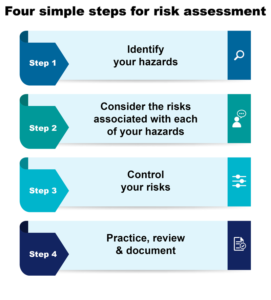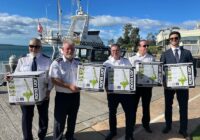Guidelines from the Australian Maritime Safety Authority
These guidelines aim to assist small DCV operations to undertake a risk assessment as part of the vessel’s safety management system.
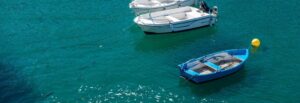
These guidelines recognise the need for a different risk assessment approach for smaller operations when compared to larger more complex operations noting that smaller operations need to address different hazards.
For larger operations with possibly more people on board a vessel and more equipment, there is an additional level of risk complexity to that operation. For operations other than small DCVs refer to AMSA’s Practical Guide to Risk Management for Domestic Commercial Vessel Operations.
Risk assessment process
To start your journey on undertaking a risk assessment you should consider the following questions in relation to your operations:
- What could cause you harm?
- What could go wrong?
- How likely is it to happen?
- How bad will it be?
- How can you stop or reduce the chance of it happening?
- What can you do now to be safer if it does happen?
Answering these 6 questions will help you get into the right frame of mind to identify the hazards and risks associated with your small DCV operations, and then implement appropriate controls to eliminate or reduce those risks.
Step 1: Identify your hazards
“…a hazard has the potential to cause death, personal injury, and illness.”
In identifying hazards, it will be useful to think about the ‘types of operations’ being undertaken onboard the vessel – for example, a commercial fisher might have different hazards to consider when catching garfish, than when fishing for crabs.
As an example, some hazards to consider when fishing for garfish might be fishing at night or working with a net – similarly, hazards when fishing for crabs might be operating long distances from shore or hauling heavy pots.
Some hazards are more general in nature across all ‘types of operation’, such as:
- weather conditions and sea state
- overloading the vessel
- mechanical breakdown
- sharps including knives and hooks
To identify hazards specific to your vessel’s operation it is recommended to consider your ‘types of operation’ and for each identified hazard, think about what could go wrong and how it could potentially endanger your life or that of the crew.
Discuss your hazards openly with your crew, family and friends – those who care most for your safety are generally the ones who will be most impacted if you weren’t to return home.
It is encouraged to discuss your work experiences with other small DCV operators who are likely to be conducting similar operations and are considering similar hazards in their risk assessment – you might find that a group discussion raises hazards that you hadn’t considered.
Step 2: Identify the risks associated with your hazards
Risks come about from working within a hazardous environment, which may have a negative impact on your safety.
Now that you have identified hazards for each of your ‘types of operation’, begin to consider some of the risks associated with each one. Using the previous example of fishing for garfish, some of the risks associated with the hazards of this operation, being fishing at night, or working with a net, might be drowning or entanglement – and in fishing for crabs, some of the risks associated with the hazards of operating long distances from shore or hauling heavy pots might be drowning or serious injury.
At this point, it is good practice to record your hazards and risks, alongside each of your ‘types of operation’. For example:

Step 3: Control your risks
Effective controls assist in managing the risks bought about by a hazard.
Now that you’ve identified your hazards and the risks associated with those hazards, you can begin to select a series of ‘actions’ or ‘controls’ to manage your hazards and risks.
Below is a ranking of measures that you should consider when applying your risk controls.
You should always try and eliminate the risk, which is the most effective control.
If this is not reasonably achievable, you should try and minimise the risk by working through the other alternatives in the order below. Administrative controls and Personal Protective Equipment are the least effective at reducing risk, however, they are often the most achievable, so must be maintained.
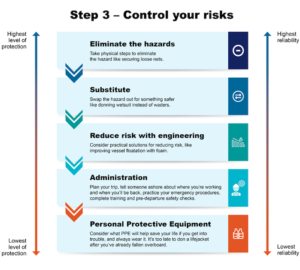
Step 4: Practice, review & document
This is one of the most important steps.
Documenting your risk assessment (see Table 1) will assist in your daily operations and can act as a checklist prior to embarking.
Practice makes perfect and your safety deserves time for you to practice the work that you’ve put into this risk assessment.
The risk assessment is a working document and should be reviewed annually and after any incident or near miss.
Some questions to consider when reviewing and practicing your controls:
- Are you comfortable that your control measures are minimising your risks and making your job safer?
- Are you missing any hazards or risks in your original table?
- A simple rule of thumb in reviewing your risk assessment is to practice and continuously refine it as required.
Table 1 – examples of hazards and risk as part of a risk assessment process
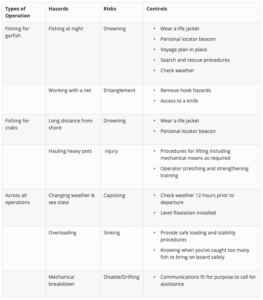
Appendix B – Examples of risk controls related to the hazard of weather
Some examples of risk controls to address the hazard of weather. Some of these controls reduce the likelihood of weather hazards, some reduce the consequences, and some do both.
- Check short- and long-term weather forecasts and seek regular updates
- Know local conditions, winds, tides current and flood flow
- Local knowledge of safe passages
- Visual observations – Beaufort scale
- Barometer
- Radar
- Sea state guidelines
- Plan trip departure and timing to suit weather
- Have an escape plan (mooring, safe anchorage, shelter, return home)
- Communicate travel plans
- Choose location / Alternative location / Change in operation area/ Cancel trip
- Be prepared / Have sufficient fuel and filters, check bilge system, secure loading and dinghy tow
- ropes
- Know your limits
- Safe speed
- GPS/ Compass
- Secure equipment and loads / No loose gear onboard
- Rough weather procedures in place
- Wear lifejackets
- Radio communication / mobile phone / emergency contacts at hand
- Safety equipment onboard
This information was sourced from the AMSA website – https://www.amsa.gov.au/






